 |
 |
|
 |
Senate committee votes not to recommend Molnau’s confirmation |
 |
 |
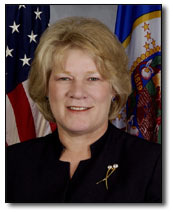 |
|
Lt. Gov. Carol Molnau |
After two hours of hearing testimony and discussing policy decisions, the Senate
Transportation Committee March 30 voted 8-7 not to recommend confirming Lt.
Gov. Carol Molnau as Mn/DOT’s commissioner.
"Today’s vote was a sad display of partisanship and a huge disservice
to Minnesotans," Gov. Tim Pawlenty said in a written statement following
the committee’s action.
"Carol Molnau is exceptionally well prepared to serve as Commissioner
of Transportation. As House Transportation Committee chair and as commissioner,
she has twice led landmark efforts resulting in the largest infusions of transportation
dollars in state history.
"In just fourteen months as commissioner, Carol Molnau has proven her
leadership in transportation time and time again. We passed and began implementing
the largest road, bridge and transit package in history. Last year was the biggest
construction season in history—and it's only getting bigger," he said.
Whether or not the lieutenant governor will remain transportation commissioner
is up to the members of the full Senate, which could meet on the issue yet this
legislative session. Molnau will continue serving as commissioner unless a majority
of senators decides not to confirm her appointment.
"As I told the Senate committee during my confirmation hearing, I am so
proud of the work all of you do for the citizens of Minnesota," Molnau
said today in a letter to employees.
"I want you to know what an honor and privilege it is to serve as commissioner
of transportation. It is because of your professionalism and dedication to the
citizens of Minnesota that my job is so rewarding and I look forward to our
future working together," she added.
Additional information:
|
back

|
 |
Vandals cause fatal damage to trees on I-35 median in Pine County |
 |
 |
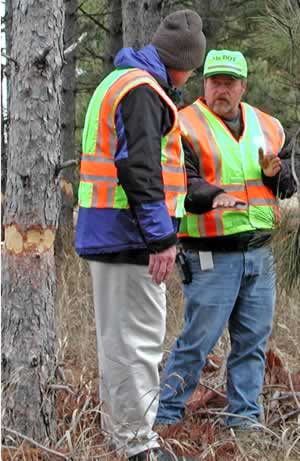 |
|
Tom Jacobson, district landscape specialist, interviews
with KARE-TV reporter Ken Speake about the incident. Photo by John
Bray |
Within a year or two, a mature stand of 64 red pine trees in the I-35 median
near Banning Junction in Pine County will die, the result of their being "girdled"
by vandals.
While plowing the freeway in early March, a Duluth/District1 employee discovered
damage to the trees. The trees were planted in the 1970s following completion
of the roadway that links the Twin Cities and Duluth.
Tom Jacobson, district landscape specialist, said girdling—cutting a band of
bark about a half-inch deep around the trees’ circumferences—will stop their
flow of nutrients and eventually cause death. The nearly perfectly straight
red pines range from 5 to 14 inches in diameter.
Illegal cutting of trees on state right of way is not uncommon and is usually
related to their blocking of sightlines to a business or other property. In
this instance, however, that seems unlikely because the area is relatively undeveloped.
Jacobson said he has seen other cases of tree vandalism, but they usually involve
someone cutting a few trees and removing them.
John Bray, special assistant to the district engineer at Duluth, said law enforcement
officials attribute the motive to simple vandalism, clearing the view to a nearby
billboard or convenience store or eventually harvesting the trees to build a
cabin or other structure.
Bray said, however, that wanton vandalism is not likely because of the time
involved and the precision of the girdling and because there is a high demand
for red pine for building purposes. It’s feasible, he said, that the vandals
expect to purchase the trees after they are cut down and sold by a contractor.
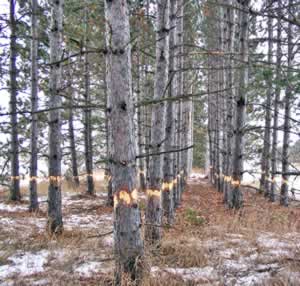 |
|
Sixty-four red pine trees in the I-35 median in Pine
County will die within a year or two because of damage inflicted on them
by vandals. The mature trees are valued at $20,000. Photo by John Bray
|
Pine County authorities may seek felony charges because the damaged trees are
valued at $20,000.
Jacobson said the district will replant the area with a mixture of tree species
and landscape quality plants.
"Our first priority, though, is directed at the removal of the damaged
trees to minimize further damage to the stand of red pines," Jacobson said.
By Craig Wilkins
|
back

|
 |
Spring floods force closing state highways in Marshall County |
 |
 |
A regular harbinger of spring—flooded roads—resulted in Bemidji/District 2’s
closing parts of Hwy 220 and Hwy 317 in Marshall County.
The flooding on Hwy 317 closes the bridge over the Red River of the North that
connects Hwy 220 with I-29 in North Dakota.
Hwy 220 is closed between Marshall County Roads 4 and 5.
The highway sections were closed on March 29 and remain closed until further
notice. Both are located on the western side of the county along the state’s
border with North Dakota.
Steve Hufnagle, area maintenance supervisor at Thief River Falls, said his
crews barricaded those parts of the highways due to water over the road.
Extensive flooding has already occurred in northeastern North Dakota. Weather
officials attribute much of the flooding due to rapid melting of the heavy snow
pack that accumulated this winter.
For information on statewide road conditions, dial 511 or log onto www.511mn.org.
|
back

|
 |
West Bush Lake bridge over I-494 removed |
 |
 |
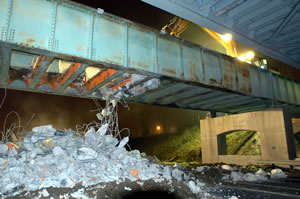 |
|
The West Bush Lake Road Bridge over I-494 in Bloomington
was removed last week as part of a three-year project to improve I-494
between Hwy 5 and Hwy 100 in the Twin Cities. Photo by Dave Gonzalez
|
The trolls were scrambling last week when the West Bush Lake Road Bridge over
I-494 in Bloomington was removed.
The bridge removal is part of a three-year project to add a third lane and
improve interchanges on I-494 between Hwy 5 and Hwy 100 in the Twin Cities west
metro area. A new West Bush Lake Road bridge is expected to open later this
year.
The project began in 2003 and is expected to be completed in 2005. This is
just the first stage of a larger, multi-year project to reconstruct 18 miles
of I-494 between Interstate 394 in Minnetonka to the Minnesota River in Bloomington.
Visit the Metro Division I-494 Web site at
http://www.dot.state.mn.us/metro/projects/i494/index.html for more information.
By Donna Lindberg
|
back

|
 |
Minnesota's 2004 river navigation season officially opens |
 |
 |
The Twin Cities waterway system opened for business March 20, when the first
towboat, the M/V Reggie G., entered St. Paul via the Mississippi with a tow
of 12 barge loads of cement.
"To arrive this early, the M/V Reggie G. had to batter her way through miles
of 15-18 inch ice on Lake Pepin," said Dick Lambert, Ports and Waterways Section.
"Most tows would not attempt this, but the Reggie G. has 5,600 horsepower and
the crew is experienced at breaking ice."
According to the Corps of Engineers, the earliest tow arrival in St. Paul was
on March 4 in 1984 and 2000. The latest arrival on record was May 11, 2001,
due to flood waters. The average opening date is March 20.
"The Minnesota barge and towing industry is hoping that 2004 tonnage will increase
over last year," said Lambert. "In 2003 Minnesota shipped 7.5 million tons of
grain on the Mississippi River to New Orleans for export. Normally we ship over
nine million tons of grain, which is the state's main river export."
Other exports include potash, asphalt, scrap iron and petroleum. The river
system also brings sand and gravel, fertilizer, salt, cement, coal and caustic
soda to Minnesota.
Each barge carries 1,500 to 1,650 tons of freight—15 times more freight than
a rail car and 60 times more freight than a truck. One gallon of fuel can move
one ton of freight 514 miles on the river.
Minnesota has five ports on the Mississippi and Minnesota rivers—Minneapolis,
St. Paul, Savage, Red Wing and Winona.
For more information on waterway navigation, check out the Web site at: http://www.dot.state.mn.us/boat.html.
By Donna Lindberg
|
back

|
 |
Willmar’s Art Bolland receives Gerald R. Rohrbach Award |
 |
 |
 |
|
Art Bolland catches up with his e-mail and other office
duties upon his return to work. Photo by Sandy East |
Art Bolland, Willmar/District 8 materials engineer, earned the Gerald R. Rohrbach
Award for his contributions in the field of pavement design and performance
at this year’s Minnesota Pavement Conference.
The conference, now in its eighth year, focuses on the technical aspects of
pavement research, design and performance.
The award is presented in the memory of Gerald "Gerry" Rohrbach,
who served as Mn/DOT’s director of Materials and Road Research until his retirement
in 2002. He died of cancer later that year.
Scot Bolland of Maple Grove, Bolland’s son, accepted the award for his father
because Bolland was hospitalized during his recent three-month battle with pancreatitis.
Bolland returned to work on a part-time basis on March 24.
His career with Mn/DOT started in 1966, including 30 years with District 8.
Bolland held several posts with the department including serving as director
of Materials and Road Research.
Receiving the award was humbling, Bolland said, because it is usually given
to prominent researchers in the field.
"This is the first time they’ve given the award to someone from a district
office and, by extension, to my cohorts—the front-line people out there crawling
around on the roads, trying to fix them and tracking their performance,"
he said.
Among those who contacted him, he said, was Dave Newcomb, a former University
of Minnesota pavement researcher who now serves as vice president of the National
Asphalt Paving Association in Virginia.
On his first day back at work since December, Bolland said he was also grateful
for the support he received from co-workers at District 8, the Maplewood Lab
and other offices and from thousands of others who contacted him via a Web site
operated by Caring Bridge, an organization that connects people who have serious
illnesses with friends, family and people who have similar conditions.
"The Caring Bridge Web site made it possible for me to post my condition,
report my progress and stay in touch with lots of people without having to tell
my story over again thousands of times," he said.
By Craig Wilkins
|
back

|
 |
Concrete Pavers Association honors Mn/DOT for technical expertise |
 |
 |
Technical expertise demonstrated in concrete paving projects earned recognition
for Mn/DOT, other government agencies and contractors from the Concrete Paving
Association of Minnesota.
The association presented the awards March 18 in Rochester during its annual
recognition event. Representatives from the association, local governmental
units and Mn/DOT chose the award winners.
Other government units receiving awards included Olmsted County, Owatonna,
St. Paul, Austin and the Metropolitan Airports Commission.
Awards for technical excellence were given in several categories including
divided urban and rural highways, state highways and county and township roads.
Award criteria include ride smoothness, joint construction, project complexity
and appearance, said Joel Williams, contract administration, Construction, and
a member of the judging panel.
The Metro District earned two paving awards. The district was cited for its
work rebuilding Hwy 100 between Duluth Street and Glenwood Avenue in Golden
Valley and for restoring concrete pavement on Hwy 77 between Hwy 62 and I-494.
Duluth/District 1 was honored for its work on Hwy 194 (Mesaba Avenue) in Duluth
while the Mankato District earned an award for rebuilding Hwy 60 between Heron
Lake and Windom.
The Brainerd District earned recognition for a concrete overlay project on
Hwy 10 between Motley and Staples; the Willmar District earned honors for reconstructing
a 1.5-mile section of Hwy 212 in Olivia.
The Metro District was also cited for managing traffic successfully on heavily
traveled Hwy 100 while it was under reconstruction in Golden Valley.
By Craig Wilkins
|
back

|
 |
Environmental group honors Mn/DOT efforts to curtail salt, sand use |
 |
 |
Practices such as anti-icing and pre-wetting helped Mn/DOT earn environmental
stewardship awards from the Freshwater Society for reducing the amount of salt
and sand used for winter highway maintenance.
The society and a consulting firm, The Fortin Co., honored the department for
implementing the Salt Solutions program and other efforts that use de-icing
chemicals more effectively. Cited for their efforts were Wendy Frederickson,
Salt Solutions coordinator; Kathy Schaefer, Community Transportation Assistance
Program coordinator, Maintenance Operations Research, and four members of Duluth/District
1’s maintenance staff.
The awards cite the recipients’ outstanding work to lessen the environmental
impacts associated with winter highway maintenance, said Jeanne Prok, the society’s
program director.
Frederickson was cited for her role as the department’s Salt Solutions coordinator;
Schaefer was recognized for providing related training to city, county and staff
from other government units.
Prok said measures such as "dialing down" application rates for salt
and cutting the use of sand benefited the state’s environment during the winter.
Duluth/District 1 pioneered developing and using techniques that enable individual
snowplow operators to determine the most effective salt application rates based
on factors such as air and ground temperatures, precipitation and current road
conditions.
The district also equipped most of its snowplows for pre-wetting and trained
operators to use ground-oriented sanders and related equipment to determine
the optimal rates for salt and other chemical applications. District 1’s Salt
Solutions coordinators Holly Johnson, Virginia, and Steve Baublitz, Duluth,
earned recognition for their efforts. Greg Pierzina, maintenance supervisor
at Virginia, and Tim Sheehy, district maintenance superintendent, received honors
for implementing pre-wetting, anti-icing and other practices to reduce salt
use.
Sheehy said the district has cut the amount of chlorides used per storm, including
the cold and snowy 2003-04 winter. The district has also reduced sand use to
lower runoff into drains and waterways, airborne dust levels and spring clean-up
costs.
District 1, Sheehy said, will continue its efforts.
"We’ll continue to implement anti-icing throughout the district, improve
our tools such as liquid de-icers and equipment, train our operators in best
practices continue to reduce sand and chemical use while maintaining acceptable
levels of service for the public," he said.
By Craig Wilkins
|
back

|
 |
Jim Povich’s art takes flight in St. Cloud |
 |
 |
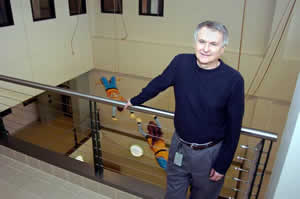 |
|
Jim Povich stands above the papier-mâché
sculpture he and his wife, Jude, created for Mn/DOT's newly remodeled
St. Cloud/District 3 office and Conference Center. Photo by Dave Gonzalez
|
Two brightly colored forms, suspended in mid-flight, greet visitors to Mn/DOT's
newly remodeled St. Cloud/District 3 office and Conference Center. The papier-mâché
pair are the work of artists and sculptors, Jim Povich and his wife, Jude.
The couple started working on the trapeze artists after earlier attempts by
St. Cloud employees to get artwork brought into the building was left up in
the air. Initially, budget woes brought a group of employees together to find
a creative solution to the lack of funding for artwork in the St. Cloud building.
After an attempt by the Art Committee to solicit artwork from employees produced
only a handful of submissions, the group went back to the drawing board. In
the meantime, the State Arts Board had its funding restored; and the group decided
to work with the Arts Board. That was months ago.
"Visitors were starting to comment on the sterile and stark look of the building;
I got tired of waiting to hear from State Arts Board," said Povich, who took
matters into his own hands—literally.
How did the idea for TRAPEZE ARTISTS take flight? Years ago, Povich remembered
seeing plaster trapeze artists hanging in the Butler Square Building during
a visit to the warehouse district near the Target Center.
"I thought our three-story lobby was perfect to create that type of art. We
thought it would be a weekend project," said Povich, who admits he and Jude
had never done that type of art project before. "Actually, the project took
two months of nights and weekends to complete—100 hours in the end requiring
considerable drying time," he added.
EDITOR’S NOTE: You can read the entire Povich article in District
3’s January 2004 newsletter. To read other district newsletters and learn
about local news and features, click on the links provided on Mn/DOT Newsline’s
navigation bar.
By Cathy Clark, district public affairs coordinator
|
back

|
 |
|
 |



